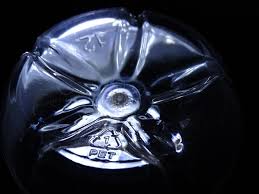2.3 Environmental impact of bottled water
Mineral water has a high environmental impact due to the production, transport and disposal of plastic containers or PET: just think in fact that to produce 1 kg of polyethylene terephthalate known under the abbreviation PET (which produces about 25 bottles from 1.5 liters) over 17 liters of water are required (therefore for each liter two are wasted) and 2 kg of oil.

The P.E.T. it is the typical plastic of water bottles and other carbonated drinks. It is also used for: food films, probe balls, fabrics, glasses. A 1.5 l PET bottle weighs 35 g, so with one kg of PET 30 bottles are manufactured. The production of one kilogram of PET also requires 17.5 kg of water; so, paradoxically, to transport 45 liters of water almost half is consumed. Water in plastic bottles costs from 2 to 4.5 euros per package (6 bottles of 1.5 l). In reality the actual cost of the water contained in the bottles is only 1% of the cost of total production, while the packaging absorbs 60%.
Every year 1.7 million tons of plastic bottles are produced, whose recycling is often not economically sustainable due to the low cost of the material, above all compared to the volume that it occupies.
The road of many of those tons of PET unfortunately ends up in incinerators anyway, from here in the combustion enormous quantities of dioxin, hydrochloric acid and heavy metals are released into the atmosphere while at least 1/3 of the burned material remains as a residue to dispose of in landfills.
Not to mention the bottles that are left awkwardly in the environment where they take millions of years to decompose or are thrown into the sea often causing the death of several animal species including dolphins.
The polluting power of PET is also increased by the energy that burns to produce it.
To produce 1000 bottles, in fact, it takes 6.2 GJ multiplied by 1535 (the quantity produced in a year) to get 9517 GJ.
Another aspect to consider is the transport of these bottles: for example in Italy about 80 percent of the transports in our country take place on rubber and the trucks put into circulation only for the market of packaged water are estimated to be around 300 thousand. The average distance is 1,000 km and the average consumption is 1 liter of diesel per 3 km, for a total emission of 265,000 tons of carbon dioxide. In a nutshell: a bottle of water emits as much CO2 as a machine makes to make 1 km.
Besides all this, recent studies have shown a number of dangers inherent in PET, such as:
-
the reuse of PET, both for heating food and for storing liquids, is highly discouraged. Recent studies have, in fact, highlighted its dangerousness, given that PET tends to deteriorate and spread in the food present inside the container.
-
PET releases antimony, a toxic metalloid, within the limits set by law if the bottles are stored at room temperature. If, on the other hand, the bottles are subjected to higher temperatures and / or stored for a long time, the quantity of the metalloid can increase dangerously.
-
As its name points out, PET contains phthalates, plasticizers that make plastic more flexible, generally considered harmless. Too bad that a German study by Johann Wolfgang Goethe University in Frankfurt, published online in 2009, in addition to listing numerous previous studies that detected hormone-mimic phthalates in mineral water bottled in PET bottles.


